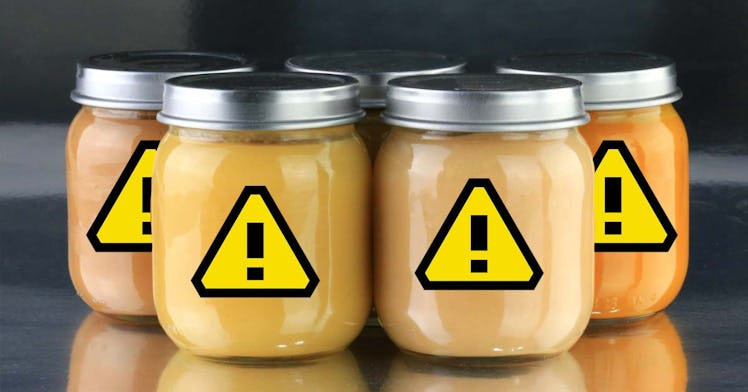FDA Announces Plan To Reduce Toxic Metals In Baby Food — What to Know
Here's what parents of babies should know.

In early February of 2021, a bombshell congressional report revealed that four major baby food manufacturers sold baby food products that had far higher than safe levels of arsenic, lead, cadmium, and mercury — otherwise known as toxic heavy metals.
The report also found that the level of toxic heavy metals found in these foods was at higher levels than what is allowed in other products to be sold to consumers, like bottled water. And now, it’s led to the FDA taking action with a new program called “Closer to Zero,” which is an action plan for reducing the levels of toxic heavy metals in baby foods. Here’s what parents need to know.
What Did The Congressional Toxic Metals Report Say?
The crux of the report showed that the federal government barely regulates the production of baby food. The problem has been long understood, but the report revealed that the baby food detailed had hundreds of parts per billion of toxic metals when the allowable amount of toxic metals should be in the single parts per billion.
The brands fingered in the report for selling baby foods with high levels of toxic metals were Gerber, Beech-Nut Nutrition Company, Nurture, Inc (which sells Happy Baby Products), and Hain’s Celestial Group, Inc, (which sells Earth’s Best Baby Food.)
But just because those were the brands singled out in the report doesn’t mean that other brands are safer. In fact, per the report, Walmart, Campbell Soup, and Sprout Organic foods reportedly refusing to cooperate in the investigation, which led the Congressional investigators to have concerns that there may be even higher levels of toxic metals in those baby food brands. (Campbell Soup denies that they didn’t cooperate with the investigation and released a written statement, and a 2019 letter, they wrote to congress as part of the investigation.)
Why Do Toxic Metal Levels Matter?
Long-term exposure to higher than safe levels of toxic metals can harm the development of babies’ brains, and in the short term, babies can have skin conditions, lesions, and hard patches of skin develop on the soles of their feet.
What Is The FDA’s New Campaign, “Closer to Zero,” and What Will it Do?
The FDA just announced a plan called “Closer to Zero” which identifies actions the FDA will take to reduce exposure to toxic elements, namely metals, in baby foods. On their website, they specifically call out arsenic, lead, cadmium, and mercury, as four metals that require action.
Here’s what the FDA will do to tackle this multifaceted problem — one born out of the fact that there are toxic elements everywhere, per their website:
- Advance research on dietary exposures to toxic elements
- Set “action levels” on the fight against toxic metal levels in baby food
- Encourage adoption of best practices by the industry to lower toxic element levels in agricultural products
- Increase enforcement, compliance of toxic elements targets
- Monitor progress against toxic metals over time
The FDA notes that reducing levels of toxic elements in foods is “complicated and multifaceted,” (which is because some metals, like arsenic, are so widespread in food) and that they need to ensure that “measures taken to limit elements in foods do not have unintended consequences— like eliminating… foods that have significant nutritional benefits or reducing the presence of one toxic element while increasing another.”
The FDA released a series of steps that they would take in order to act on their plan as well as a timeline in order to fight the problem that will last in several phases, from April 2021 to “beyond.” They also added that they would still be working on finalizing action levels for arsenic in apple juice (a huge problem for American children), continue to develop their analytical methods on toxic elements in food, continue toxicological research into the impact of toxic metals in kids, and more. You can read the full plan here.
What Can A Parent Do Now?
Because the plan is one that will obviously take time to get research on and implement, it’s not as though parents will see a difference in baby food safety immediately. This is an industry-wide problem and one that will take time to fix.
In the meantime, babies need to be fed. Parents might want to consider making their own baby food — a solution only accessible to time and money-rich parents, a reality that makes this plan all the more important.
Or, you can look at the Consumer Reports list of baby foods that have been independently tested for toxic metals.
Also, keep in mind that rice is one of the foods most commonly laced with arsenic — and brown rice is the bigger offender — so soak, and rinse rice before cooking it and try to eat white rice instead. Tuna is also an offender. You can look at this list from the FDA to see what foods you should be avoiding.
This article was originally published on